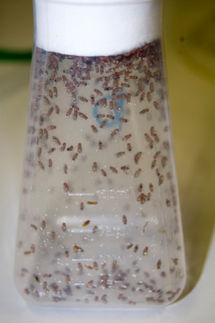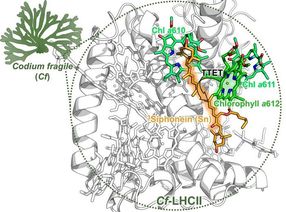Optimal population size allows maximum predictability of evolution
Advertisement
evolution in very large populations of plants, animals or fungi can be predicted far less easily than one would expect. This has been shown by research at the Institute for Theoretical Physics of the University of Cologne and the Laboratory of genetics at Wageningen University, part of Wageningen UR. The researchers combined genetic information from a fungus with computer models which simulate the course of evolution. They concluded that, while evolution in small populations is known to be unpredictable, this is also the case for very large populations. There is an optimal population size for predicting evolutionary outcomes in every situation.
Evolution is exciting – you never know exactly what the result will be. Over time, mutations resulting in improved fitness have a good chance of surviving in a population. Mutations which decrease fitness, on the other hand, are much less likely to ultimately remain in a significant part of the population and thus influence the development of the species. But there are no safe bets, even for beneficial mutations.
Researchers would like to know whether - and if so how - evolution can be predicted. For instance, one can, in retrospect, ask whether it could have been predicted that giraffes with long necks would eventually develop on earth through evolution. Researchers consider the question of the predictability of evolution either theoretically, using computer models, or practically, via research in nature or in the laboratory. In the laboratory, the predictability of evolution can, for example, be examined by monitoring how often fast-evolving microorganisms evolve along the same route. The more often the route and end result are the same, the more predictable evolution can be considered to be.
The Dutch-German team merged the two techniques, combining a laboratory approach with computer models. The Wageningen group used its laboratory to provide knowledge about the fitness profile of a fungus. All 256 possible combinations of eight mutations in various places in the DNA of the fungus were charted. The scientists calculated the effect on the growth of the fungus for each combination of mutations. The growth rate is an important component of the fitness of the fungus. Mutations with a positive effect on growth rates therefore have a greater chance of remaining definitively established after a large number of new generations. The likelihood is not one hundred percent, however.
In small populations, it is likely that each positive mutation that occurs accidentally will ultimately contribute to the evolution of the organism. The larger the population, the more positive mutations will arise, and the greater the chance will be that the best possible positive mutation is among them. And, as individuals with this mutation will be the fittest, it will repeatedly win the competition and contribute to evolution when the experiment is repeated. This means that, the larger a population, the more predictable its evolution should become. But this turns out to not quite be the case.
The German group processed the fitness data regarding the mutations of the Wageningen mould in a computer. They discovered that the evolutionary outcome is actually more difficult to predict in very large populations. This phenomenon is caused by the fact that they contain more individuals with not one but two or more mutations. Since the number of beneficial mutation combinations is much higher than the number of favourable mutations themselves, however, the predictability of evolution again declines in very large populations. In other words, evolution can be most easily predicted for populations that are not too small and not too big.
Original publication
Ivan G. Szendro, Jasper Franke, J. Arjan G. M. de Visser, and Joachim Krug Predictability of evolution depends nonmonotonically on population size PNAS 2013 110 (2) 571-576; 2012.
























































